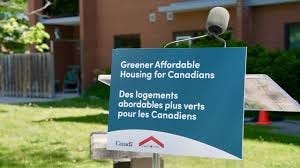The Vancouver Affordable Housing Controversy: A Case Study of 1807 Larch Street
In Vancouver’s highly competitive real estate market, the issue of affordable housing has become a focal point of both public discourse and…
In Vancouver’s highly competitive real estate market, the issue of affordable housing has become a focal point of both public discourse and government policy. The provincial government, led by the NDP, has made numerous commitments to increase the availability of affordable housing. However, a recent case involving a development project at 1807 Larch Street in Vancouver’s Kitsilano neighborhood has sparked significant controversy, raising questions about what truly constitutes “affordable” housing and how government initiatives are implemented.
The Larch Street Project: Promises and Reality
The project at 1807 Larch Street is a five-storey, 64-unit residential building developed by Jameson Development Corp., a family-owned company led by Tony Pappajohn. Scheduled to open next month, the units are priced at the high end of the market, with rents ranging from $2,650 to $4,300 per month. These figures have sparked considerable debate, especially in light of the promises made by the government when the project was first announced.
Three years ago, the then-Housing Minister, David Eby, touted the Larch Street project as a groundbreaking example of the NDP government’s commitment to providing “affordable” housing. In a news release dated December 16, 2021, Eby declared, “Another affordable rental housing building will soon be available for people who work and live in Vancouver.” The release emphasized the government’s investment in affordable housing and used the terms “affordable” and “affordability” repeatedly to underline the significance of the project.
The key initiative behind this promise was the Housing Hub, a $2-billion program launched by the NDP government to subsidize developers and deliver housing units at affordable rents and prices. The Housing Hub was envisioned as a transformative measure, with Eby boasting that the $2 billion in a rotating line of credit would build thousands of affordable housing units across the province. The Larch Street project was one of the flagship developments under this initiative, receiving a $31.8 million low-interest loan from the Housing Hub. This subsidy was intended to ensure that 54 of the 68 units in the building would be rented at or below market rates.
The Definition of “Affordable”
The crux of the controversy surrounding the Larch Street project lies in the definition of “affordable.” For many residents and housing advocates, the rental rates of $2,650 to $4,300 per month do not align with the common understanding of affordable housing. In a city where housing costs are among the highest in the world, these rent levels are seen as far beyond the reach of the average worker or family.
Critics argue that the government’s approach to affordable housing is fundamentally flawed if such high rental rates are considered affordable. They point out that the term “affordable” has become a political buzzword, used to describe a wide range of housing that may not be truly accessible to those who need it most. This has led to growing skepticism about government housing initiatives and their effectiveness in addressing the real needs of the population.
Poor Land Utilization: A National Perspective
Canada, the world’s second-largest country by land area, and British Columbia, a province larger than 120 countries, should not be facing a housing crisis of this magnitude. The inability to provide affordable housing despite having vast land resources indicates a serious issue of poor land utilization. It reflects a failure to strategically develop land to meet the growing demands of urban populations. The concentration of development in already densely populated areas, coupled with restrictive land-use policies, has driven up property values and rents, making housing increasingly unaffordable for the average citizen.
Allegations of Government Alignment with Real Estate Interests
The Larch Street project, with its high rental prices despite being labeled “affordable,” has fueled allegations that the NDP government may be aligned with real estate interests. Critics argue that such developments are designed to keep housing prices superficially high, benefiting developers and investors at the expense of the public. This perception of alignment with the so-called “Real Estate Mafia” undermines trust in government initiatives and raises questions about who truly benefits from these projects.
A Better Model for Affordable Housing
To genuinely address the housing crisis, a different model is needed — one that focuses on true affordability, rather than market-driven definitions. A mixed-income housing model, where units are allocated to different income levels, could ensure that a portion of new developments is reserved for low- and middle-income families. Additionally, non-profit housing organizations and cooperatives should be empowered and funded to develop housing that is insulated from market pressures. By prioritizing social housing over profit-driven developments, the government can better meet the needs of its citizens.
The Economic Impact of Freeing Up More Land
Freeing up more land for urban development could significantly boost the economy by increasing the supply of housing, thereby reducing prices and making homes more affordable. Expanding the boundaries of cities and encouraging the development of new residential areas would alleviate the pressure on existing housing markets. This approach would also create jobs in construction and related industries, contributing to overall economic growth.
Regulations for Converting Land for Urban Infrastructure
To ensure that land is used efficiently and sustainably, regulations for converting land for urban infrastructure must be carefully designed. These regulations should prioritize the development of affordable housing, public amenities, and green spaces. Additionally, they should include provisions for community consultation, environmental impact assessments, and long-term urban planning to ensure that new developments are well-integrated into existing communities and meet the needs of future generations.
Why the Housing Project Fails the Middle Class, New Immigrants, and Families
The high rental rates of the Larch Street project make it a bad idea for working middle-class families, new immigrants, and renting families who are struggling to find affordable housing in Vancouver. These groups are already facing significant financial pressures, and the lack of truly affordable options exacerbates their challenges. Instead of providing relief, projects like Larch Street contribute to the growing inequality in the housing market, leaving many behind.
Conclusion
The 1807 Larch Street project in Vancouver’s Kitsilano neighborhood was initially heralded as a model for affordable housing development under the NDP government’s Housing Hub initiative. However, with rents set at $2,650 to $4,300 per month, the project has become a symbol of the challenges and contradictions inherent in Vancouver’s housing market. As the city and the province continue to seek solutions to the housing crisis, the lessons learned from this project must inform future policies to ensure that affordable housing truly means what it says. Only by adopting more inclusive and sustainable approaches can the government hope to address the real needs of its citizens and make housing genuinely affordable for all.






